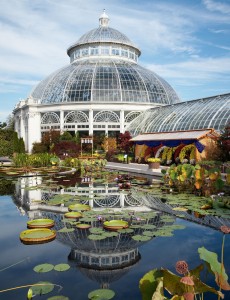In Celebration of Autumn, Japanese Gardens, and Kiku
Posted in Exhibitions, Kiku on October 8 2009, by Plant Talk
 |
Todd Forrest is Vice President for Horticulture and Living Collections. |
 |
Jessica Blohm is Interpretive Specialist for Public Education. |
 With comparable latitude and climate as eastern North America, Japanese gardens and hillsides in fall become a dappled canvas of scarlet, gold, and orange, just as they do here. Millions of Japanese travel in cars, buses, and trains to reach a favorite viewing spot—often a rugged mountain landscape or a garden belonging to a temple or shrine—to view the changing leaves and flowers.
With comparable latitude and climate as eastern North America, Japanese gardens and hillsides in fall become a dappled canvas of scarlet, gold, and orange, just as they do here. Millions of Japanese travel in cars, buses, and trains to reach a favorite viewing spot—often a rugged mountain landscape or a garden belonging to a temple or shrine—to view the changing leaves and flowers.
Maples (kaede) are the main source of stunning autumn colors along with emerald conifers, bamboo, chrysanthemums (kiku), and Japanese perennials, grasses, and ferns. Beginning October 17, the Enid A. Haupt Conservatory Courtyards will again come alive with two gardens that celebrate ancient Japanese horticultural traditions and the brilliant hues of chrysanthemums and Japanese garden plants in Kiku in the Japanese Autumn Garden.
For the past two years, chrysanthemums trained using traditional Japanese methods have been the centerpiece of the Garden’s autumn offerings. This year will be the final showing of this special presentation of kiku, and it will be combined with other elements that make viewing Japanese gardens in autumn memorable.
Garden design has been an important Japanese art for centuries. Many traditional Japanese gardens were closed to the public. Built by the elite for their own use or as temple gardens, they served as places for peaceful worship and quiet contemplation. Gardens in Japan are not simply a collection of plants; they are an interpretation of the natural landscape. Each element has a specific meaning and inspiration.
- Stone provides the framework of the landscape and is symbolic of Japan’s rocky shores and volcanic peaks;
- Water, or an expression of water created with raked sand and gravel, represents the sea, quiet ponds, and mountain streams; and
- Plants, which are a garden’s life-force, represent both physical and spiritual life.
Kiku in the Japanese Autumn Garden will showcase a Mum and Bonsai Garden in which the elaborate and breathtaking “thousand bloom” and “driving rain” styles of kiku will be joined by contemporary mum displays, including cones, columns, and spheres. This new garden will feature many of the 13 different horticultural classes of chrysanthemums, providing the opportunity for visitors to learn about the fascinating history of the mum as it traveled from its native China to Japan and ultimately to the West.
In a Kiku and Maple Garden, chrysanthemums will add drama to the brilliant autumn color of Japanese maples. The refined elegance of Japanese perennials, grasses, and ferns will complement the “single stem” and “cascade” kiku styles. The combination of scarlet maples, emerald conifers, and red, yellow, and white chrysanthemums will transport visitors to the spectacular autumn landscapes of Japan.
The sophisticated and ancient art of bonsai will be on display again as well. For the first two weeks of the exhibition, an educational display of bonsai grown by members of the Yama Ki Bonsai Society will enliven the Conservatory. A selection of bonsai, including forest bonsai on slabs and single specimens in pots, will be displayed amid the chrysanthemums of the Mum and Bonsai Garden for the duration of the exhibition.
Four handcrafted pavilions, known as uwaya, will protect the kiku from the elements and add an elegant touch of architecture to the display. Built of Douglas fir, bamboo, and reed mats, the uwaya evoke the pavilions, tea houses, and gates that are essential elements of Japanese gardens.

